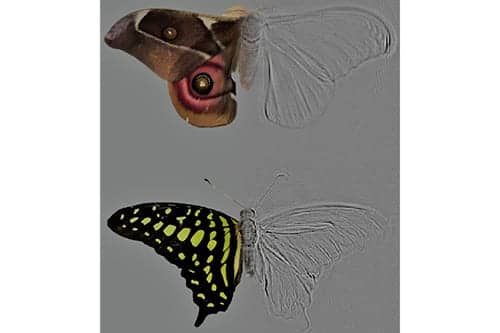Bats hunt at night using echolocation. The technique, which is also known as biological sonar, first evolved around 65 million years ago and enables bats to search for and find prey putting huge predation pressure on nocturnal insects. One defense that many nocturnal insects evolved is the ability to hear the ultrasonic calls of bats, which allows them to actively evade approaching bats.

Many moth species, however, cannot hear. The team of researchers from the University of Bristol wanted to investigate the alternative defenses against bats that some species of deaf moths might have evolved. An article summarizing the research is published on the university’s website.
Using scanning electron microscopy, the team from Bristol’s School of Biological Sciences discovered that the thorax scales of the moths Antherina suraka and Callosamia promethea looked structurally similar to fibers that are used as noise insulation, so wanted to explore whether the thorax scales of moths might be acting in some way to absorb the ultrasonic clicks of bats and dampen the echoes returning to the bat, offering the moths a type of acoustic camouflage.

The team measured that the scales on the body of a moth absorb as much as 85% of the incoming sound energy and that the scales can reduce the distance a bat would be able to detect a moth by almost 25%, potentially offering the moth a significant increase in its survival chances.

Dr Thomas Neil, Research Associate from Bristol’s School of Biological Sciences and lead author, said: “We were amazed to see that these extraordinary insects were able to achieve the same levels of sound absorption as commercially available technical sound absorbers, whilst at the same time being much thinner and lighter.
“We are now looking at ways in which we can use these biological systems to inspire new solutions to sound insulating technology and analyze the scaling on a moth’s wing to explore whether they too have sound absorbing properties.“
The study was funded by the Biotechnology and Biological Sciences Research Council (BBSRC) and the Engineering and Physical Sciences Research Council (EPSRC).
Original Paper: Neil TR, Shen Z, Robert D, Drinkwater BW, Holderied MW. Thoracic scales of moths as a stealth coating against bat biosonar. Journal of the Royal Society Interface. 2020;17.
Source: University of Bristol, Journal of the Royal Society Interface
Images: University of Bristol, Thomas R. Neil, Marc W. Holderied




